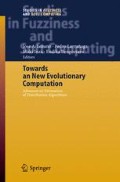Summary
This chapter presents results on the application of the concept of entropy to estimation of distribution algorithms (EDAs). Firstly, the Boltzmann mutual information curves are introduced. They are shown to contain a lot of information about the difficulty of the functions. Next, a design method of discrete benchmark functions is presented. The newly developed approach allows the construction of both single and random classes of functions that obey a given collection of probabilistic constraints. This application and the next — the construction of low cost search distributions — are based on the principle of maximum entropy. The last proposal is the linear entropic mutation (LEM), an approach that measures the amount of mutation applied to a variable as the increase of its entropy. We argue that LEM is a natural operator for EDAs because it mutates distributions instead of single individuals.
Access this chapter
Tax calculation will be finalised at checkout
Purchases are for personal use only
Preview
Unable to display preview. Download preview PDF.
References
A. Agresti. Categorical Data Analysis. John Wiley and Sons, 1990.
I. Beinlich, H. R. Chavez, and G. Cooper. The ALARM monitoring system: A case study with two probabilistic inference techniques for belief networks. In Artificial Intelligence in Medical Care, pp. 247–256, 1989.
T. M. Cover and J. A. Thomas. Elements of Information Theory. Jonh Wiley and Sons, New York, 1991.
I. Csiszar. I-Divergence geometry of probability distributions and minimization problems. Annals of Probability, 3:146–158, 1975.
L. M. de Campos. Independency relationship and learning algorithms for singly connected networks. Experimental and Theoretical Artificial Intelligence, 10:511–549, 1998.
K. Deb, J. Horn, and D. E. Goldberg. Multimodal deceptive function. Complex Systems, 7:131–153, 1993.
D. E. Goldberg. Simple genetic algorithms and the minimal deceptive problem. In Lawerance Davis, editor, Genetic Algorithms and Simulated Annealing, pp. 74–88. Pitman, 1987.
D. E. Goldberg. Genetic Algorithms in Search, Optimization and Machine Learning. Addison-Wesley, Reading, MA, 1989.
D. E. Goldberg, K. Deb, and J. Horns. Massive multimodality, deception, and genetic algorithms. Lecture Notes in Computer Sciences, Parallel Problem Solving from Nature PPSN II, pp. 37–46, 1992.
C. Huang and A. Darwiche. Inference in belief networks: A procedural guide. Journal of Approximate Reasoning, 15(3):225–263, 1996.
C. T. Ireland and S. Kullback. Contingency tables with given marginals. Biometrika, 55:179–188, 1968.
E. T. Jaynes. Information theory and statistical mechanics. Physics Review, 6:620–643, 1957.
E. T. Jaynes. Where do we stand on maximum entropy? In R. D. Levine and M. Tribus, editors, The Maximum Entropy Formalism. MIT Press, 1978.
F.V. Jensen and F. Jensen. Optimal junction trees. In 10th Conference on Uncertainty in Artificial Intelligence, pp. 360–366, Seattle, 1994.
R. Jiroušek and S. Přeučil. On the effective implementation of the iterative proportional fitting procedure. Computational Statistics and Data Analysis, 19:177–189, 1995.
S. L. Lauritzen. Graphical Models. Oxford Press, 1996.
F. Leisch, A. Weingessel, and K. Hornik. On the Generation of Correlated Artificial Binary Data. Technical Report 13, Viena University of Economics and Bussines Administration, Viena, 1998.
P. M. Lewis. Approximating probability distributions to reduce storage requirements. Information and Control, 2:214–225, 1959.
T. Mahnig and H. Mühlenbein. Comparing the adaptive Boltzmann selection schedule SDS to truncation selection. In Third International Symposium on Adaptive Systems ISAS 2001, Evolutionary Computation and Probabilistic Graphical Models, pp. 121–128, La Habana, 2001.
T. Mahnig and H. Mühlenbein. Optimal mutation rate using Bayesian priors for estimation of distribution algorithms. Lecture Notes in Computer Sciences, 2264:33–48, 2001.
C. H. Meyer. Korrektes Schliesen bei Unvollständiger Information. PhD thesis, Fernuniversität Hagen, 1998. In German.
H. Mühlenbein. The equation for the response to selection and its use for prediction. Evolutionary Computation, 5(3):303–346, 1998.
H. Mühlenbein and R. Höns. The estimation of distributions and the maximum entropy principle. Evolutionary Computation, 2004. To appear.
H. Mühlenbein and T. Mahnig. Evolutionary optimization and the estimation of search distributions. Journal of Approximate Reasoning, 31(3):157–192, 2002.
H. Mühlenbein, T. Mahnig, and A. Ochoa. Schemata, distributions and graphical models in evolutionary optimization. Journal of Heuristics, 5(2):213–247, 1999.
H. Mühlenbein and G. Paas. From recombination of genes to the estimation of distributions I. Binary parameters. Lecture Notes in Computer Sciences, Parallel Problem Solving from Nature PPSN IV, 1141:178–187, 1996.
D. Nilsson. An efficient algorithm for finding the M most probable configuration in Bayesian networks. Statistics and Computing, 2:159–173, 1998.
D. Nilsson. The computation of moments of decomposable functions in probabilistics expert systems. In Third International Symposium on Adaptive Systems ISAS 2001, Evolutionary Computation and Probabilistic Graphical Models, pp. 116–120, La Habana, 2001.
A. Ochoa, R. Höns, M. Soto, and H. Müehlenbein. A maximum entropy approach to sampling in EDA — the single connected case. Lecture Notes in Computer Sciences, 8th Iberoamerican Congress on Pattern Recognition CIARP 2003, 2905:683–690, 2003.
J. Pearl. Probabilistic Reasoning in Intelligent Systems: Networks of Plausible Inference. Morgan Kaufmann, 1988.
J. Pearl. Causality: Models, Reasoning and Inference. Cambridge University Press, 2000.
C. E. Shannon. A mathematical theory of communication. Bell System Technical Journal, 27:379–423, 1948.
M. Soto. Un Estudio sobre los Algoritmos Evolutivos Basados en Redes Bayesianas Simplemente Conectadas y su Costo de Evaluación. PhD thesis, Instituto de Cibernética, Matemática y Física, La Habana, 2003. In Spanish.
M. Soto and A. Ochoa. A factorized distribution algorithm based on polytrees. In Congress on Evolutionary Computation CEC 2000, pp. 232–237, California, 2000.
J. Whittaker. Graphical Models in Applied Multivariate Statistics. John Wiley and Sons, 1989.
Author information
Authors and Affiliations
Editor information
Editors and Affiliations
Rights and permissions
Copyright information
© 2006 Springer-Verlag Berlin Heidelberg
About this chapter
Cite this chapter
Ochoa, A., Soto, M. (2006). Linking Entropy to Estimation of Distribution Algorithms. In: Lozano, J.A., Larrañaga, P., Inza, I., Bengoetxea, E. (eds) Towards a New Evolutionary Computation. Studies in Fuzziness and Soft Computing, vol 192. Springer, Berlin, Heidelberg. https://doi.org/10.1007/3-540-32494-1_1
Download citation
DOI: https://doi.org/10.1007/3-540-32494-1_1
Publisher Name: Springer, Berlin, Heidelberg
Print ISBN: 978-3-540-29006-3
Online ISBN: 978-3-540-32494-2
eBook Packages: EngineeringEngineering (R0)

